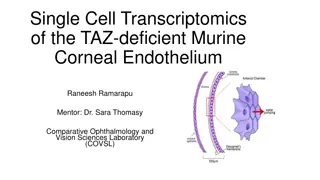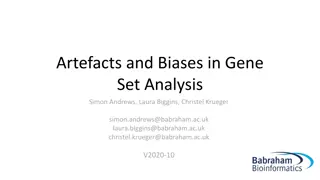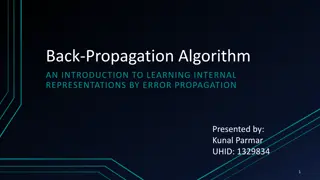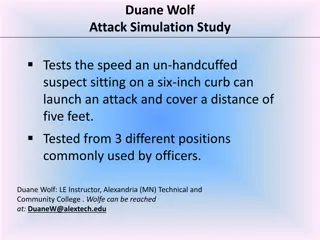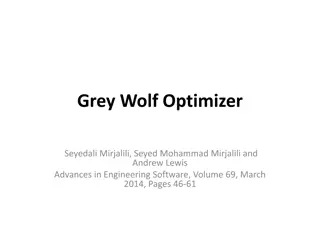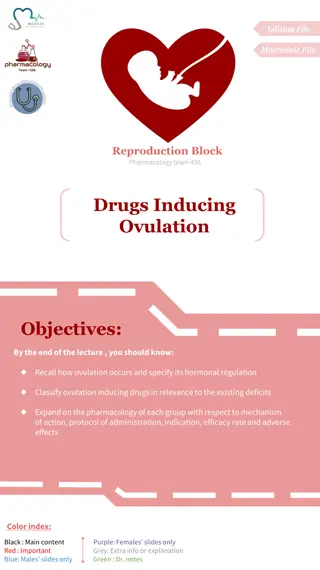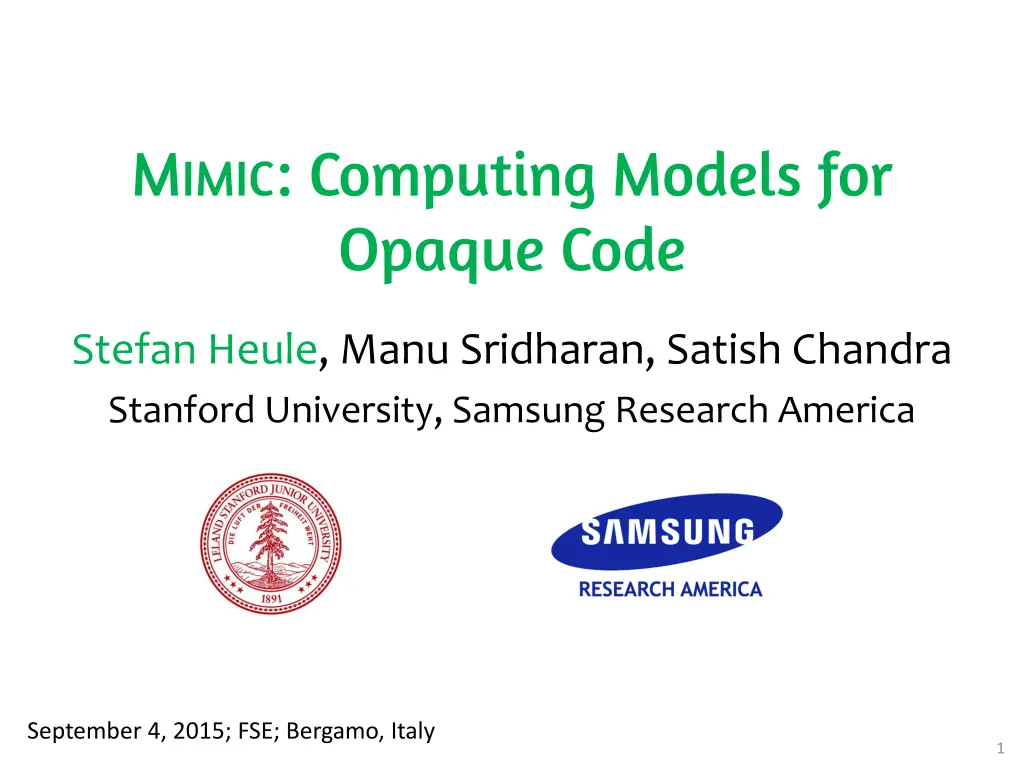
Opaque Code Computing Models & Execution Traces
Explore the challenges posed by opaque code in programming and the development of suitable models for program analysis. Discover how to observe and trace execution in JavaScript, including the introduction of proxies in ECMAScript 6 for advanced control.
Download Presentation

Please find below an Image/Link to download the presentation.
The content on the website is provided AS IS for your information and personal use only. It may not be sold, licensed, or shared on other websites without obtaining consent from the author. If you encounter any issues during the download, it is possible that the publisher has removed the file from their server.
You are allowed to download the files provided on this website for personal or commercial use, subject to the condition that they are used lawfully. All files are the property of their respective owners.
The content on the website is provided AS IS for your information and personal use only. It may not be sold, licensed, or shared on other websites without obtaining consent from the author.
E N D
Presentation Transcript
MIMIC: Computing Models for Opaque Code Stefan Heule, Manu Sridharan, Satish Chandra Stanford University, Samsung Research America September 4, 2015; FSE; Bergamo, Italy 1
Computing Models for Opaque Code Opaque code Code is executable Source not available, or hard to process Challenge: Program analysis in the presence of opaque code Model Representation suitable for program analysis 2
Setting Opaque code in JavaScript Standard library has native implementation Arrays, Regex, Date, etc. Code obfuscated before deployment var arr = ['a','b','c','d']; var x = arr.shift(); // x is 'a' // arr is now ['b','c','d'] var _0x4240=["\x61","\x62","\x63","\x64", "\x73\x68\x69\x66\x74"]; var arr=[_0x4240[0],_0x4240[1], _0x4240[2],_0x4240[3]]; var x=arr[_0x4240[4]](); 3
Goals Problem statement: Given an (opaque) function ? and some inputs ?, automatically find a model that behaves like ? Models should be executable (JavaScript code) Agnostic to program analysis abstraction 4
Observing Opaque Code Opaque code is executable Observe return values Observe heap accesses on shared objects read field 'length' of arg0 // 4 read field 0 of arg0 // 'a' has field 1 of arg0 read field 1 of arg0 // 'b' write 'b' to field 0 of arg0 has field 2 of arg0 read field 2 of arg0 // 'c' write 'c' to field 1 of arg0 has field 3 of arg0 read field 3 of arg0 // 'd' write 'd' to field 2 of arg0 delete field 3 of arg0 write 3 to field 'length' of arg0 return 'a' ['a','b','c','d'].shift(); How can we get such detailed execution traces? Ideally without having to change the JavaScript runtime 5
Execution Traces in JavaScript ECMAScript 6 will introduce proxies Proxies are objects of JavaScript with programmer-defined semantics Intercept field reads, writes, enumerations of fields, etc. var proxy = new Proxy(target, handler); 6
Example of Proxies in ECMAScript 6 var handler = { get: function(target, name) { return name in target? target[name] : 42; } }; var p = new Proxy({}, handler); p.a = 1; console.log(p.a) // prints 1 console.log(p.b) // prints 42 Strategy: proxy arguments to opaque code, record interactions 7
Traces Dont Tell the Full Story Traces contain partial information only Where do values come from? Input generation read field 'length' of arg0 // 4 read field 0 of arg0 // 'a' has field 1 of arg0 read field 1 of arg0 // 'b' write 'b' to field 0 of arg0 has field 2 of arg0 read field 2 of arg0 // 'c' write 'c' to field 1 of arg0 has field 3 of arg0 read field 3 of arg0 // 'd' write 'd' to field 2 of arg0 delete field 3 of arg0 write 3 to field 'length' of arg0 return 'a' What is the program counter? Control flow reconstruction What non-heap- manipulating computation is happening? Random search 8
Approach Overview Given opaque function + initial inputs All Loop Structure Initial Inputs Input Gen Loop Detect Inputs Final Model Random Search 9
Input Generation Iterate Until Fixpoint or Enough Inputs 1. Start with initial inputs 2. Record traces for inputs 3. Extract locations from traces that are being read 4. Generate inputs that differ in those locations 5. Also, generate heuristically interesting inputs ['a','b','c','d'] [], ['b','b','c','d'], ['a','b','c'], ['b','foo','bar','def'], 11
Control Structure Reconstruction What statement did a trace event originate from? Trivial for straight-line code Less clear for loops read field 'length' of arg0 // 4 read field 0 of arg0 // 'a' has field 1 of arg0 read field 1 of arg0 // 'b' write 'b' to field 0 of arg0 has field 2 of arg0 read field 2 of arg0 // 'c' write 'c' to field 1 of arg0 has field 3 of arg0 read field 3 of arg0 // 'd' write 'd' to field 2 of arg0 delete field 3 of arg0 write 3 to field 'length' of arg0 return 'a' Abstract trace to skeleton read; read; has; read; write; has; read; write; has; read; write; delete; write; return; 12
Control Structure Reconstruction (2) Problem can be viewed as learning a regular language read; read; has; read; write; has; read; write; has; read; write; delete; write; return; read; read; (has; (delete;| read; write;))* delete; write; From only positive examples Theoretical result: impossible [Gold 67] 13
Control Structure Reconstruction (3) Limit ourselves to at most one loop There still might be multiple possible loop structures Generate many proposals Rank them based on how many traces they explain Heuristic to break ties read; read; (has; (delete;| read; write;))* delete; write; read; read; (has; delete;| has; read; write;)* delete; write; read; read; (has; (read; write;| delete; has; read; write;))* delete; write; read; read; (has; (read; write;| delete;))*has; read; write; delete; write; 14
Control Structure Reconstruction (4) Probabilistically choose a loop proposal Loop ranked ? is chosen with probability ?loop ? 1 ?? 1 We use: ?loop= 0.9 and ? = 0.7 Multiple runs of procedure will eventually pick correct loop 15
Control Structure Reconstruction (5) Given the a loop proposal, we get an initial model var n0 = arg0.length var n1 = arg0[0] for (var i = 0; i < ?; i += 1) { var n2 = ?in arg0 if (?) { delete arg0[?] } else { var n4 = arg0[?] arg0[?] = ? } } delete arg0[?] arg0.length = ? return? return; read; read; ( has; ( delete; | read; write; ) )* delete; write; var n0 = arg0.length var n1 = arg0[0] for (var i = 0; i < 0; i += 1) { var n2 = 1in arg0 if (false) { delete arg0[0] } else { var n4 = arg0[1] arg0[0] = 'b' } } delete arg0[4] arg0.length = 4 return'a' 16
Randomized Search Then, apply random search (Markov Chain Monte-Carlo (MCMC) sampling inspired) Randomly mutate the current program Evaluate it with a fitness function Accept better programs, and sometimes worse ones, too 17
Fitness Function Fitness function Run model on all inputs Compare all traces against real traces Score Zero: if trace is matching perfectly Partial score if only parts of trace are matching 19
Randomized Search (3) Program mutations Select statement at random Replace a random subexpression with a new random expression For field read, replace either the field or receiver For conditionals, replace condition For loops, change loop bound No need to remove/add statements Random expressions follow JavaScript grammar Plus any local variable, constants seen in traces Likelihood to generate expression of depth ? decreases exponentially with ? 20
Random Search Result After some number of iteration, score goes to zero This is a model var n0 = arg0.length var n1 = arg0[0] for (var i = 0; i < (n0-1); i += 1) { var n2 = (i+1) in arg0 if (n2) { var n3 = arg0[i+1] arg0[i] = n3 } else { delete arg0[i] } } delete arg0[i] arg0.length = i returnn1 What about the empty array?? Doesn t actually match the control flow structure 21
Full Overview Repeat until success: All Loop Structure Initial Inputs Input Gen Loop Detect Inputs Input Cat1 Model1 Search Input Cat2 Model2 Search Merge Categorizer Input Catn Modeln Search Unknown Conditions Model Final Model Search Cleanup 22
Input Categories for shift For shift Category for empty array Category for non-empty arrays var n0 = arg0.length if (false) { /* model for non-empty arr */ } else { arg0.length = 0 } var n0 = arg0.length if (n0) { /* model for non-empty arr */ } else { arg0.length = 0 } 23
Implementation Notes Randomly generate models might not terminate Stop execution if trace get too long Newly allocated objects Don t show up in trace (only when returned) Approach: Allocate at beginning of model, then randomly search for population code if (false) {result[0] = 0; } 24
Optimizations Only use subset of inputs, not all inputs Heuristic to choose 20 diverse inputs How long is the trace? How does the initial model score? At the end, validate with all inputs If it fails, restart with failed inputs added Embarrassingly parallel search: exploit multiple cores Don t propose nonsensical programs Type analysis var n0 = arg0[arg0]; 25
Evaluation JavaScript Array Standard Library every filter forEach indexOf push reduce reduceRight shift some sort1 splice1,2 toString3 unshift1 lastIndexOf map pop concat1,2 join2 reverse1 slice2 Problems 1. Multiple loops 2. Bugs in proxy implementation (not officially released) 3. Missing program mutations 26
Evaluation (2) We contributed some of our models to WALA, a static analysis library for JavaScript New models increase analysis precision Also found a previous model to be wrong, and several to be incomplete (sparse arrays) 27
Summary Opaque code problematic for analysis Automatically synthesize models Using MCMC random search Program traces to evaluate models Source code and replication package https://github.com/Samsung/mimic/ @stefan_heule http://stefanheule.com/ 29



